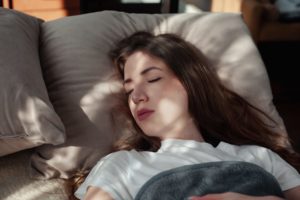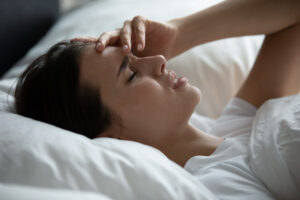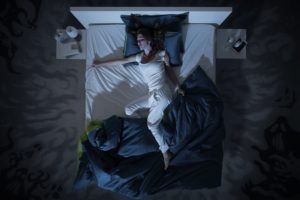Is Lucid Dreaming Dangerous?
- Lucid dreaming is a state of semi-awareness where dreamers can control their dreams.
- Frequent lucid dreaming may disrupt regular sleep patterns and lead to sleep deprivation.
- Lucid dreams may appear similar to nightmares, sleep paralysis, and the dreamer’s own reality, which can cause anxiety and confusion.
- Prolonged and intense lucid dreaming may overstimulate the dreamer, leading to heightened stress and worsened sleep.
Each night, people dream for a total of about two hours as they sleep. Dreams might help process emotions and form memories of waking experiences. Researchers propose that dream interpretation may also provide the dreamer with personal insight into their life and unconscious mind .
During a lucid dream , the sleeper gains awareness that they are dreaming and can sometimes control the trajectory of the dream. People are interested in lucid dreaming in hopes that it may stimulate psychological growth , allow them to try impossible acts like flying, or even treat nightmares .
However, some experts caution against using methods to intentionally induce lucid dreaming until more research on the safety of lucid dreaming has been conducted.
Risks of Lucid Dreaming
Although more research is needed, some experts suspect lucid dreaming could come with negative consequences. The most concerning potential dangers of lucid dreaming are disrupted sleep and mental health issues.
Disrupted Sleep
Although lucid dreaming generally occurs during rapid eye movement (REM) sleep, lucid and non-lucid REM sleep periods differ from one another. Preliminary studies have revealed that lucid dreams incorporate unusual patterns of brain activity with elements of both sleep and wakefulness. In this regard, lucid dreaming may be conceived as a hybrid form of consciousness. Researchers caution that this may interfere with processes that normally occur during REM sleep, notably memory consolidation and emotional regulation.
More research is needed to determine if being more “awake” during your dreams makes sleep less restful. Some studies have found that more lucid dreaming is associated with a lower quality of sleep , but a closer look revealed that the connection was not significant if nightmares were accounted for. It could be that people who are more likely to have lucid dreams are also more likely to have sleep-disrupting nightmares, not that lucid dreaming disrupts sleep directly.
Sometimes people try to induce lucid dreaming in ways that interrupt the natural sleep cycle, causing fragmented sleep . These lucid dreaming induction methods often involve intentionally disrupting sleep:
- Mnemonic Induction of Lucid Dreams (MILD): With this technique, a sleeper repeatedly tells themselves that next time they are dreaming, they will be aware they are dreaming. Then, they try to fall back asleep with that intention on their mind. Often, they engage in this self-talk after intentionally waking up after about five hours and staying awake for 30 to 120 minutes before returning to sleep.
- Wake Back to Bed (WBTB): This lucid dreaming technique involves purposely waking up in the early morning , then taking a nap. Lucid dreaming becomes more likely during the nap.
- Senses Initiated Lucid Dream (SSILD): Like the MILD technique, SSILD has a person intentionally wake up after about five hours of sleep. Then, they move their attention between different stimuli, such as sights, sounds, and physical sensations, before falling back asleep.
- External Stimulation: With the help of another person, external stimuli are administered to the sleeper to trigger lucidity as they sleep. Along the same lines, people may take substances before going to bed with the aim of directly disrupting the systems that regulate sleep.
Since disrupted and insufficient sleep are associated with a greater risk of physical and mental health issues, experts caution that engaging in lucid dreaming induction techniques on a frequent basis may come with inherent risks.
More research, particularly long-term studies and studies looking at daytime tiredness, are needed to determine if lucid dreaming produces the same negative effects that are commonly seen alongside disrupted or insufficient sleep.
Mental Health Concerns
Research studies have found that lucid dreaming may impact the mental health of certain people. Whether that impact is positive or negative may depend on the nature of their lucid dreaming experiences.
For example, studies have found that lucid dreaming may help reduce nightmares in people with post-traumatic stress disorder (PTSD). Although not all studies on the topic have replicated this finding, others have found lucid dreaming can reduce anxiety and depression in people who have both PTSD and nightmares.
However, lucid dreaming might pose a risk to people who experience psychosis . Lucid dreaming involves metacognition , a type of self-awareness that requires thinking of yourself from an outside perspective . Some researchers point out that this third-person view of one’s self during a lucid dream is similar to a dissociative mental state. Dissociation is a feeling of being detached from your body and trouble discerning what is real that is experienced by some people with mental illness. This state of mind is present in early psychosis.
More research is needed, but preliminary studies suggest that lucid dreaming is linked to psychosis both positively and negatively. Researchers of one study found that intentionally attempting to induce lucid dreaming is associated with depression, dissociation, obsessive compulsive symptoms, and symptoms that are characteristic of schizophrenia. It is not clear whether people with related mental health conditions are more likely to attempt lucid dreaming, or whether deliberately inducing lucid dreaming contributes to mental health symptoms, perhaps through disrupted sleep.
Among people who experience lucid dreaming, those who rate the experience as positive and more intense appear less likely to have adverse mental health symptoms.

Tips for Safe Lucid Dreams
If you are interested in trying to lucid dream, you can use the existing research as your guide to minimize risks. If you feel any confusion or uncertainty about whether or not lucid dreaming is safe for you, ask your doctor or mental health professional for advice.
Consider Why You Want to Lucid Dream
Being aware of why you want to lucid dream can help you evaluate if lucid dreaming is working for you, or if you should let the practice go. People may feel interested in lucid dreaming for a variety of reasons, such as wanting to experience altered consciousness without taking drugs, or overcoming fears and becoming stronger psychologically. If you find that lucid dreams are not helping you achieve the goals you set out to achieve, then the benefits may not be worth the potential risks.
Avoid Lucid Dreaming If You Have Certain Health Conditions
More research is needed to fully understand how lucid dreaming relates to mental health. Until research can better explain the effects of lucid dreaming, people with certain conditions might want to avoid intentionally trying to lucid dream.
For example, if you have experienced dissociation or psychosis, such as feelings that you are disconnected from yourself or trouble distinguishing fantasy from reality, lucid dreaming may heighten these symptoms. Along the same lines, since lucid dreaming induction techniques can lead to fragmented sleep, these may not be appropriate for people who already experience disrupted sleep due to a sleep disorder.
People who live with sleep problems or mental health conditions should speak with a mental health professional or sleep specialist before trying to induce lucid dreaming.
Make Up for Lost Sleep
If you decide to try and induce lucid dreaming through methods that disrupt your sleep, be sure you still obtain an adequate amount of sleep overall. For adults, the recommended sleep time is at least seven hours per night . You may find you need even more sleep than this if your sleep has been disrupted due to lucid dreams.
Use Non-Disruptive Lucid Dream Induction Techniques
Not all lucid dreaming induction techniques involve intentionally disrupting sleep. If you want to try lucid dreaming, consider beginning with techniques that are less likely to wake you up during the night. For example:
- Lucid Dreaming Induction Devices: These portable devices strap around your head, like an eye mask. They monitor your sleep using sensors, then attempt to induce lucidity when they estimate you are in a REM sleep stage. Different devices operate differently, with some using lights and others using sound as a signal to help trigger lucidity within the dream.
- Keeping a Dream Diary: Although not all research has found this method to be effective, some people report that keeping a dream diary helps increase the number of lucid dreams they have. To keep a dream diary, write down as much as you can remember from any dream you have as soon as you wake up, even if you wake up during the night.
- Reality Testing (RT): To conduct a reality test, you do something to determine if you are awake or dreaming, such as repeatedly checking a clock to see if it reads the same every time you look. In theory, if reality testing is performed often enough while awake, it becomes a habit that spills over into a dream. Then, when a person reality tests during a dream, the unrealistic test results help them recognize they are dreaming and become lucid.
- Video Game Playing: Although video games are not technically a lucid dreaming induction method, research suggests that people who spend more time playing interactive games may experience more lucid dreams.
Myths About Lucid Dreams
Movies such as Inception or Nightmare on Elm Street have popularized wild notions of what can go wrong with lucid dreaming, but these scenarios are not backed by evidence.
For example, it is a myth that a person can become permanently stuck in a lucid dream, or that a lucid dream can last the entire night. Nor is it true that you can use lucid dreaming to interact with the dead, or with another living person in a different location. Of course, since lucid dreams feel very real, you might have the sensation of doing such things if you dream them, though they would not have happened in reality.
Lucid dreaming also does not involve alien abduction or paranormal activity, though researchers have found that people who lucid dream are also more likely to report having had paranormal experiences . This connection might be because people who are psychologically open to new experiences are generally more likely to experience altered mental states. People who frequently lucid dream may occasionally experience sleep paralysis or false awakenings , which can be frightening experiences but which generally resolve on their own.

Still have questions? Ask our community!
Join our Sleep Care Community — a trusted hub of product specialists, sleep health professionals, and people just like you. Whether you’re searching for the perfect mattress or need expert sleep advice, we’ve got you covered. Get personalized guidance from the experts who know sleep best.
References
21 Sources
-
National Institute of Neurological Disorders and Stroke. (2019, August 13). Brain basics: Understanding sleep., Retrieved December 15, 2021, from
https://www.ninds.nih.gov/health-information/public-education/brain-basics/brain-basics-understanding-sleep -
Scarpelli, S., Bartolacci, C., D’Atri, A., Gorgoni, M., & De Gennaro, L. (2019). The functional role of dreaming in emotional processes. Frontiers in Psychology, 10, 459.
https://pubmed.ncbi.nlm.nih.gov/30930809/ -
Edwards, C. L., Ruby, P. M., Malinowski, J. E., Bennett, P. D., & Blagrove, M. T. (2013). Dreaming and insight. Frontiers in Psychology, 4, 979.
https://pubmed.ncbi.nlm.nih.gov/24550849/ -
Paulson, S., Barrett, D., Bulkeley, K., & Naiman, R. (2017). Dreaming: A gateway to the unconscious? Annals of the New York Academy of Sciences, 1406(1), 28–45.
https://pubmed.ncbi.nlm.nih.gov/28618458/ -
Vallat, R., & Ruby, P. M. (2019). Is it a good idea to cultivate lucid dreaming? Frontiers in Psychology, 10, 2585.
https://pubmed.ncbi.nlm.nih.gov/31803118/ -
Soffer-Dudek, N. (2020). Are lucid dreams good for us? Are we asking the right question? A call for caution in lucid dream research. Frontiers in Neuroscience, 13, 1423.
https://pubmed.ncbi.nlm.nih.gov/32038133/ -
de Macêdo, T. C., Ferreira, G. H., de Almondes, K. M., Kirov, R., & Mota-Rolim, S. A. (2019). My dream, my rules: Can lucid dreaming treat nightmares? Frontiers in Psychology, 10, 2618
https://pubmed.ncbi.nlm.nih.gov/31849749/ -
Schredl, M., Dyck, S., & Kühnel, A. (2020). Lucid dreaming and the feeling of being refreshed in the morning: A diary study. Clocks & Sleep, 2(1), 54–60.
https://pubmed.ncbi.nlm.nih.gov/33089191/ -
Gott, J., Rak, M., Bovy, L., Peters, E., van Hooijdonk, C. F., Mangiaruga, A., Varatheeswaran, R., Chaabou, M., Gorman, L., Wilson, S., Weber, F., Talamini, L., Steiger, A., & Dresler, M. (2020). Sleep fragmentation and lucid dreaming. Consciousness and Cognition, 84, 102988.
https://pubmed.ncbi.nlm.nih.gov/32768920/ -
Aspy, D. J. (2020). Findings from the international lucid dream induction study. Frontiers in Psychology, 11, 1746.
https://pubmed.ncbi.nlm.nih.gov/32765385/ -
Erlacher, D., & Stumbrys, T. (2020). Wake up, work on dreams, back to bed and lucid dream: A sleep laboratory study. Frontiers in Psychology, 11, 1383.
https://pubmed.ncbi.nlm.nih.gov/32670163/ -
Aviram, L., & Soffer-Dudek, N. (2018). Lucid dreaming: Intensity, but not frequency, is inversely related to psychopathology. Frontiers in Psychology, 9, 384.
https://pubmed.ncbi.nlm.nih.gov/29623062/ -
Holzinger, B., Saletu, B., & Klösch, G. (2020). Cognitions in sleep: Lucid dreaming as an intervention for nightmares in patients with posttraumatic stress disorder. Frontiers in Psychology, 11, 1826.
https://pubmed.ncbi.nlm.nih.gov/32973600/ -
Mota, N. B., Resende, A., Mota-Rolim, S. A., Copelli, M., & Ribeiro, S. (2016). Psychosis and the control of lucid dreaming. Frontiers in Psychology, 7, 294.
https://pubmed.ncbi.nlm.nih.gov/27014118/ -
Filevich, E., Dresler, M., Brick, T. R., & Kühn, S. (2015). Metacognitive mechanisms underlying lucid dreaming. Journal of Neuroscience: The Official Journal of the Society for Neuroscience, 35(3), 1082–1088.
https://pubmed.ncbi.nlm.nih.gov/25609624/ -
Voss, U., D’Agostino, A., Kolibius, L., Klimke, A., Scarone, S., & Hobson, J. A. (2018). Insight and dissociation in lucid dreaming and psychosis. Frontiers in Psychology, 9, 2164.
https://pubmed.ncbi.nlm.nih.gov/30483185/ -
National Center for Chronic Disease Prevention and Health Promotion, Division of Population Health. (2017, March 2). How much sleep do I need? Centers for Disease Control and Prevention., Retrieved December 16, 2021, from
https://www.cdc.gov/sleep/about_sleep/how_much_sleep.html -
Mota-Rolim, S. A., Pavlou, A., Nascimento, G. C., Fontenele-Araujo, J., & Ribeiro, S. (2019). Portable devices to induce lucid dreams—Are they reliable? Frontiers in Neuroscience, 13, 428.
https://pubmed.ncbi.nlm.nih.gov/31133778/ -
Tai, M., Mastin, D. F., & Peszka, J. (2017). The relationship between video game use, game genre, and lucid/control dreaming. Sleep, 40(suppl 1), A 271.
https://academic.oup.com/sleep/article/40/suppl_1/A271/3782160 -
Drinkwater, K. G., Denovan, A., & Dagnall, N. (2020). Lucid dreaming, nightmares, and sleep paralysis: Associations with reality testing deficits and paranormal experience/belief. Frontiers in Psychology, 11, 471.
https://pubmed.ncbi.nlm.nih.gov/32256437/ -
Raduga, M., Kuyava, O., & Sevcenko, N. (2020). Is there a relation among REM sleep dissociated phenomena, like lucid dreaming, sleep paralysis, out-of-body experiences, and false awakening? Medical Hypotheses, 144, Article 110169.
https://pubmed.ncbi.nlm.nih.gov/32795836/

















